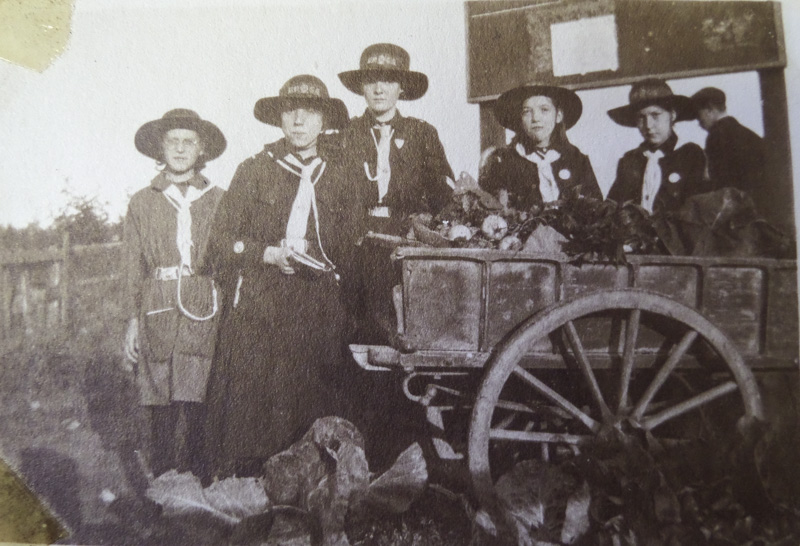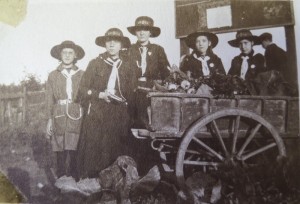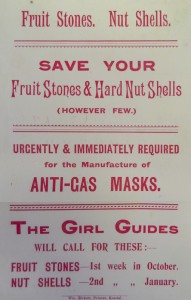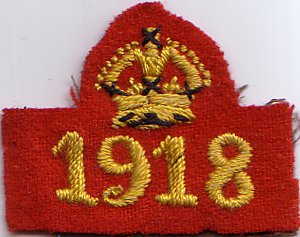
As a Guide myself, I was interested to find out about how girls and women in the local community were involved in guiding during the war years. Unfortunately, I was unable to find any archival records of guiding activity during the First World War in Lancaster. However, there were Girl Guide company logbooks from the old neighbouring county of Westmorland that give us an insight into the work of the Guides there.
Girl Guides in Westmorland in World War One
Posted by Holly Wilson, Lancaster Girls’ Grammar School
During World War One, the Girl Guides Association was still in its infancy, having only been established in 1910. By 1914, it had around 300,000 members spread out all over the country. It is difficult to determine when the local Guide groups in Kendal were actually formed but, according to the First Report of the Westmorland Girl Guides’ Association, (1) we know that on September 19th 1917, Mrs Argles was appointed as District Commissioner. (2) The report goes on to say that ‘Guiding was so new in Westmorland…,’ suggesting the group cannot have been set up much earlier than 1917. Despite this, 1st Kendal Company had 32 Guides active at the date recorded, with 20 of those enrolments new that year. Could this sudden interest in guiding be because of young girls’ interest in helping with the war effort?
Girl Guides and war work

Westmorland Girl Guides collecting vegetables for the Fleet, June 1917
Cumbria Archival Centre, Kendal: Ref WDSO 42/4/1
Included in the Westmorland Girl Guides’ Association First Report was a section documenting the ‘War work’ completed by the 1st Kendal Company in the year 1917. This included ‘orderly work each Saturday at V.A.D. Hospital,’ (3) ‘collecting fruit and vegetables each Friday during the summer months for the Fleet,’ (4) and ‘gardening on Guide Allotment.’ There was a 2nd Kendal Company as well. An excursion to Garnett Bridge is mentioned in ‘A Scrap Book Diary – Book 1, 2nd Kendal Company,’ where the Guides are described, on Saturday 14th July 1917, to have collected ‘eggs for the wounded’ before cycling to Garnett Bridge ‘for a picnic.’ This extract gives us a unique insight into how this contribution to the war effort was seamlessly integrated into typical guiding activities.
Could this sudden interest in guiding be because of young girls’ interest in helping with the war effort?

Notice concerning Girl Guides’ fruit stones collection, September 1918 Cumbria Archival Centre, Kendal: Ref WDSO 42/4/1
Like the 1st Kendal Company, the 2nd Kendal Company’s war work also involved growing vegetables for the Fleet and orderly work at V.A.D. hospital. However, they were also recorded to have collected ‘fruit stones for gas masks.’ (5) Other companies in the area included 3rd Kendal Company, Kendal High School Company, Burneside Company, Endmoor Company, 1st Lowood School Company, 1st Windermere Company, 1st Ambleside Company and Oakfield School Company but there was not a lot of detail given regarding war work. Milnthorpe Company was said to have been ‘studying Morse Signalling,’ which would have been a useful skill to have as messages may have been sent using Morse code. Staveley Company also participated in collecting fruit stones and were part of the parade for the 4th anniversary of the war on August 4th 1918.
Another thing Guides were doing during the war was collecting waste paper. The 1st Kirkby Lonsdale Company begun to collect paper in May 1917 for the benefit of the National Relief Fund. Unbelievably, by July 18th they had collected 19cwts. 20lbs, which is almost a tonne. This shows a real enthusiasm for the war effort among the Guides, as this would have been an extremely large amount of paper and will have taken a lot of effort to collect. Presumably, it would have been hugely appreciated by the National Relief Fund.
An excursion to Garnett Bridge is mentioned in ‘A Scrap Book Diary - Book 1, 2nd Kendal Company,’ where the Guides are described, on Saturday 14th July 1917, to have collected ‘eggs for the wounded’ before cycling to Garnett Bridge ‘for a picnic.’
Girl Guides in Morecambe
Although I previously mentioned a lack of information concerning Guides and their contribution towards the war effort in Lancaster, there were also two short articles about the Girl Guides in the 1915 Lancaster Girls’ Grammar School magazine, The Chronicle. (6) These show that there were Girl Guide companies around Lancaster and Morecambe during World War 1 and that some LGGS pupils were members of these companies. One article includes a description of the Girl Guides, including guiding values and what was then the motto, ‘Be prepared.’ The second article is an account of a day with the 2nd Morecambe Girl Guides on Saturday 17th October, which shows them learning skills that could be seen as useful during wartime. It describes how the Guides took part in tracking activities, which involved a few people going ahead to lay tracks for the others to follow. Some tracks, made with chalk, were ‘conspicuous’ and others were more ‘obscure,’ made with straws and leaves. The author, Phyllis Kitching, writes that they then started a fire using just one match, the way ‘all good Guides are supposed to do.’ This shows us that Girl Guides were being taught to be conservative with resources, a very important skill at the time. Once the fire was out they proceeded to practise Morse code with the smoke.
War Service badge

Girl Guides World War 1 War Service Badge
Thanks to www.lesliesguidinghistory.webs.com for permission to reproduce this image
It was common at the time for Guides to complete their War Service badge, which could be earned by 21 days of recognised voluntary war service, 100 hours of recognised agricultural work and the making of 15 specified garments, including a pair of pyjamas, 4 pairs of socks and 2 shirts. Each badge was embroidered with the specific year it was awarded in.
It was common at the time for Guides to complete their War Service badge, which could be earned by 21 days of recognised voluntary war service, 100 hours of recognised agricultural work and the making of 15 specified garments, including a pair of pyjamas, 4 pairs of socks and 2 shirts.
In the Westmorland area, 16 War Service badges were given out in total from the 2nd Kendal, 1st Casterton and 1st Windermere Girl Guide Companies. However, these were just the number of badges documented. Given the amount of war work that was reported in the logbook, it could be presumed that more Guides achieved this award. Although not all guiding companies had girls getting War Service badges, there were a considerable number who were awarded badges such as Ambulance, Fire Brigade, Sick Nurse and Senior and Junior Thrift. (7) These badges would have meant that these Guides possessed essential skills for the War time and are also ones that are not normally associated with being a Guide or a girl; at that time managing and understanding the worth of money was primarily a man’s job.
All these records point towards guiding activity in Westmorland as helping towards the war effort. It was interesting for me as a Guide to see what sort of things people of my age were expected to do in Guides at the time, as I feel there is no real point of comparison for me. Guiding now is different in the sense that there is no ‘greater good’ we are all striving towards and after ‘to serve my…. country’ was replaced in the Guide Promise, there seems to be no real sense of patriotic duty. This, I think, reflects the times they were in and the new age of guiding at the moment. Maybe one day in the future, another Guide will look back on how current Guides helped out and spent their meetings. I wonder what they might think…
- I would like to thank Mrs Workman for going to Kendal Archives in order to find these logbooks. It would not have been possible if she had not found them.
- All the archive material referred to in this article comes from the 2nd Kendal Parish Church Company Logbooks (1915-24), 5 vols. Archive ref: WDSO 42/4/1, Accession A1678, Cumbria Archival Centre, Kendal. Thank you to Girlguiding Cumbria South for granting permission for us to reproduce images from these archive materials and to them and to Girlguiding North West England for their interest in and support for this work.
- The Voluntary Aid Detachment (V.A.D.) was ‘a voluntary unit providing field nursing services, mainly in hospitals, in the United Kingdom and various other countries in the British Empire. The most important periods of operation for these units were during World War 1 and World War 2.’ (Information from Wikipedia: Voluntary Aid Detachment. Available at: https://en.wikipedia.org/wiki/Voluntary_Aid_Detachment).
- Possibly the Grand Fleet, which was the main fleet of the British Royal Navy.
- Fruit stones were used for gas masks as they were a perfect source of carbon, which was one of the main components (Timothy Cranston, 2015. Peach pits, nut shells and how they helped us win the Great War [online]. Available at: http://www.independentri.com/independents/north_east/opinion/article_38bfb054-bcee-59e7-b32e-f56d3f4c88a7.html).
- The two articles are ‘Girl Guides’ by Edna Maddocks and ‘A Day with the Girl Guides’ by Phyllis Kitching from The Chronicle of the Lancaster Girls’ Grammar School 1915, pp.18-19.
- Thrift was the idea of managing money and making money go further.

